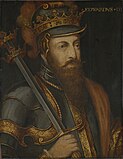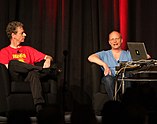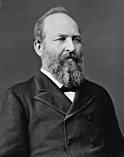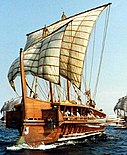Wikipedia:Today's featured article/February 2022
| << | Today's featured articles for February 2022 | >> | ||||
|---|---|---|---|---|---|---|
| Su | Mo | Tu | We | Th | Fr | Sa |
| 1 | 2 | 3 | 4 | 5 | ||
| 6 | 7 | 8 | 9 | 10 | 11 | 12 |
| 13 | 14 | 15 | 16 | 17 | 18 | 19 |
| 20 | 21 | 22 | 23 | 24 | 25 | 26 |
| 27 | 28 | |||||
February 1
SMS Oldenburg was the fourth Helgoland-class battleship of the Imperial German Navy. Built between 1909 and 1912 at the Schichau-Werke shipyard in Danzig, Oldenburg was assigned to I Battle Squadron of the High Seas Fleet for most of her career, including World War I. Oldenburg participated in all of the major fleet operations during the conflict against the British Grand Fleet, including the Battle of Jutland on 31 May and 1 June 1916, the largest naval battle of the war. The ship also saw action in the Baltic Sea against the Imperial Russian Navy. After the German collapse in November 1918, most of the High Seas Fleet was interned and then scuttled in Scapa Flow during the peace negotiations. The four Helgoland-class ships remained in Germany but were ceded to the Allied powers as war reparations; Oldenburg was given to Japan, which sold the vessel to a British ship-breaking firm in 1920. She was scrapped in Dordrecht in 1921. (This article is part of a featured topic: Battleships of Germany.)
February 2
Burnt Candlemas was a failed invasion of Scotland in early 1356 by an English army commanded by King Edward III (pictured), and was the last campaign of the Second War of Scottish Independence. Tensions on the Anglo-Scottish border led to a military build-up in 1355. In September a nine-month truce was agreed, and most of the English left. A few days later the Scots invaded and devastated Northumberland. In early November, the Scots escaladed the walls of Berwick-on-Tweed, captured the town and laid siege to its castle. The English army retook the town and marched on Edinburgh, leaving a trail of devastation 50 to 60 miles (80 to 100 km) wide. The Scots refused battle and practised a scorched earth policy, removing or destroying all food in their own territory. The English burnt Edinburgh and thoroughly despoiled Lothian. Edward's army was supplied by sea, but a winter storm scattered his fleet, forcing the English to withdraw. In 1357 a permanent peace was agreed, largely on English terms. (Full article...)
February 3
Bluey is an Australian animated television series for preschoolers that has aired on ABC Kids since October 2018. Created by Joe Brumm, the series follows Bluey, an anthropomorphic six-year-old Blue Heeler puppy (example pictured) who engages in imaginative play with her father Bandit, mother Chilli, and younger sister Bingo. The characters of Bluey each represent a particular dog breed, some of which are drawn from Brumm's personal life; he had a Blue Heeler named Bluey throughout his childhood. Overarching themes include family, growing up, and Australian culture. The program was created and is produced in Queensland; its capital city of Brisbane inspired the show's setting. Bluey won a Logie Award for Most Outstanding Children's Program in 2019 as well as an International Emmy Kids Award. It has been praised by television critics for its depiction of modern everyday family life, constructive parenting messages and the role of Bandit as a positive father figure. (Full article...)
February 4
Nodar Kumaritashvili (1988–2010) was a Georgian luge athlete who suffered a fatal crash during a training run for the 2010 Winter Olympics in Whistler, British Columbia, Canada, on the day of the opening ceremony. He became the fourth athlete to die from practice at any of the Winter Olympics, and the seventh athlete to die from practice or competition at any of the Olympic Games. Kumaritashvili, who first participated in luge when he was 13, came from a family of seasoned lugers: his grandfather had introduced the sport to the Soviet republic of Georgia, and both his father and uncle had competed when they were younger, with his uncle later serving as the head of the Georgian Luge Federation. Kumaritashvili himself began competing in the 2008–09 Luge World Cup. He had also been a student at Georgian Technical University, where he earned an economics degree in 2009 while adhering to a strict training regimen and participating in competitions. (Full article...)
February 5
New Zealand nationality law details the conditions by which a person may hold New Zealand nationality. Regulations apply to the Realm of New Zealand, which consists of the country of New Zealand itself, the Cook Islands, Niue, Tokelau, and the Ross Dependency. All persons born in the Realm before 2006 were automatically citizens at birth regardless of the nationalities of their parents. Since that year, individuals born in the Realm only receive citizenship at birth if at least one parent is already a citizen or entitled to live in New Zealand indefinitely (meaning permanent residents of New Zealand or of Australia, and citizens of Australia). Foreigners living in the Realm may be granted citizenship after becoming permanent residents. New Zealand is a former British colony and its residents were previously British subjects. While New Zealanders are no longer British, they continue to hold favoured status when living in the United Kingdom; they are eligible to vote in British elections and serve in public office there. (Full article...)
February 6
The 2015 Africa Cup of Nations Final was a football match that took place on 8 February 2015 to determine the winner of that year's African football championship. The match was held at the Estadio de Bata (pictured) in Bata, Equatorial Guinea, and was contested by Ghana and Ivory Coast. The final was 0–0 at the end of normal time, and there were also no goals in extra time, with few clear-cut chances for either team. With the match finishing level, it was decided by a penalty shoot-out. After every outfield player had taken a shot the score was tied at 8–8. The match was then decided by Ivorian goalkeeper Boubacar Barry, who saved an attempt from his Ghana counterpart Brimah Razak and then scored himself past Razak to give Ivory Coast a 9–8 shoot-out win and the title. The victory was Ivory Coast's second Africa Cup of Nations victory and lifted them from third to second place among African nations in the FIFA World Rankings. Ghana's Afriyie Acquah was named the man of the match. (Full article...)
February 7
Jesu, meine Freude (Jesus, my joy), BWV 227, is a motet by J. S. Bach. In eleven movements for up to five voices, it is his longest and most musically complex motet. It is named after the 1653 Lutheran hymn "Jesu, meine Freude" by Johann Franck; the hymn's six stanzas form the motet's odd-numbered movements. Bach used the hymn tune by Johann Crüger in five different chorale settings (example pictured). The hymn's text focuses on an emotional bond to Jesus, complementing the doctrinal text from the Epistle to the Romans used for the even-numbered movements. Jesu, meine Freude is one of the few works by Bach for five vocal parts, in a structure of symmetries on different layers. It is unclear when the motet was written. Bach scholar Christoph Wolff believed that Bach may have compiled it to educate his choir in composition techniques and theology; an earlier theory that it was written for a 1723 funeral in Leipzig is now discredited. In 1927, it became the first Bach motet to be recorded. (Full article...)
February 8
Why Marx Was Right is a 2011 book by the British academic Terry Eagleton (pictured) on the philosopher Karl Marx and Marxism. Eagleton outlines ten objections to Marxism that he attempts to refute. These include that it is irrelevant, determinist, utopian, authoritarian and opposed to reform. Eagleton says class struggle is central to Marxism and history is viewed as a series of modes of production that describe the nature and organisation of labour. He describes how revolution could lead to socialism in which the working class have control and make the state obsolete. He explores the failures of the Soviet Union and other communist countries. The book was published in 2011 and reprinted in 2018, 200 years after Marx's birth. Critics gave mixed feedback on the prose style, although the commentary on historical materialism was praised. The book was criticised for its defence of the Soviet Union and other Marxist states. (Full article...)
February 9
Apollo 5 was the uncrewed first flight of the Apollo Lunar Module (LM), which would later carry astronauts to the lunar surface. The liftoff of the Saturn IB rocket bearing LM-1 (pictured), the first LM, from Cape Kennedy followed long delays, due in part to setbacks in development of the LM at Grumman, the manufacturer. The original rocket was taken down during the delays and replaced with the one atop which the Apollo 1 fire that killed three astronauts had taken place. LM-1 arrived at the Kennedy Space Center in June 1967; the following months were occupied in testing. After further delays, the countdown began on January 21, 1968, with launch the following day. Although due to programming problems a mission different from that originally planned was executed, the mission was successful enough that a contemplated second uncrewed mission to test the LM was cancelled, advancing NASA's plans to land an astronaut on the Moon by the end of the 1960s, with a safe return to Earth. (Full article...)
February 10
Final Fantasy XIII-2 is a 2011 role-playing video game developed and published by Square Enix. XIII-2 is a direct sequel to the 2009 role-playing game Final Fantasy XIII and part of the Fabula Nova Crystallis subseries. Development of the game began in early 2010 and involved many of the key designers from the previous game. It includes modified features from the previous game, including fast-paced combat and a customizable "Paradigm" system. The development team wanted to improve on the gameplay of Final Fantasy XIII, while making the story's tone more mysterious and darker than the previous game. The new game's plot features heavy use of time travel, allowing players to jump between different time periods in the same location. The game was first released on the PlayStation 3 and Xbox 360, and later ported to Microsoft Windows, iOS, and Android. Final Fantasy XIII-2 received generally positive reviews from critics. The game was the fifth-best selling game of 2011 in Japan, and was followed by a sequel, Lightning Returns: Final Fantasy XIII. (Full article...)
February 11
Melville Fuller (February 11, 1833 – July 4, 1910) was the eighth chief justice of the United States. Born in Augusta, Maine, he graduated from Bowdoin College and practiced law in Chicago. In 1888, President Grover Cleveland appointed him to the Supreme Court. Fuller gained a reputation for collegiality and competent administrative skills. His jurisprudence was staunchly conservative: he favored free enterprise and opposed broad federal power. Fuller wrote the majority opinion in Pollock v. Farmers' Loan & Trust Co., which held that the federal income tax was unconstitutional. He joined the majority opinion in Plessy v. Ferguson, which upheld state-mandated racial segregation, and in Lochner v. New York, which struck down economic regulations on the grounds that they violated the freedom of contract. Many of his decisions were later overruled, and the majority of scholars have been critical of the Fuller Court's jurisprudence. He served as chief justice until his death in 1910. (Full article...)
February 12

Ice dance is a discipline of figure skating that historically draws from ballroom dancing. A team consists of one woman and one man. Ice dance originated as recreational social skating: couples and friends would skate waltzes, marches, and other social dances. By the early 1900s it was popular in this form around the world. The first international ice dance competition took place as a special event at the World Figure Skating Championships in 1950 in London. Ice dance was formally added to the World Championships in 1952 and became an Olympic medal sport in 1976. Dominated by British teams in the 1950s and 1960s, Soviet teams until the 1990s, and North American teams in the 2000s, the discipline lost much of its integrity as a sport in the late 1990s and early 2000s after a series of judging scandals. Ice dance has certain elements that competitors are required to perform in specific ways, including the dance lift, the dance spin, the step sequence, twizzles, and choreographic elements. (Full article...)
February 13
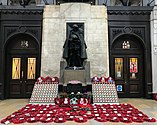
The Great Western Railway War Memorial is a First World War memorial by Charles Sargeant Jagger and Thomas S. Tait. It stands on platform 1 at London Paddington station, commemorating the 2,500 Great Western Railway (GWR) employees killed in the conflict. A third of the GWR's workforce of almost 80,000 left to fight in the war, the company guaranteeing their jobs. The memorial consists of a bronze statue of a soldier in heavy winter clothing, reading a letter from home. The statue stands on a polished granite plinth, within a white stone surround. The names of the dead are on a roll buried in the plinth. GWR chairman Viscount Churchill unveiled the memorial on 11 November 1922 in front of over 6,000 people, including the Archbishop of Canterbury, GWR officials, and relatives of the dead. When public gatherings were restricted during the COVID-19 pandemic, local communities on the GWR network laid wreaths on trains that carried them to Paddington to be laid at the memorial for Armistice Day. (Full article...)
February 14
The Beautician and the Beast is a 1997 American romantic comedy film directed by Ken Kwapis and written by Todd Graff. It stars Fran Drescher (pictured) as a New York City beautician who is hired to tutor the children of a fictional Eastern European dictator, played by Timothy Dalton. The film takes inspiration from other stories like Beauty and the Beast, The King and I, Evita, and The Sound of Music. Produced by Drescher and Paramount Pictures, The Beautician and the Beast had Drescher's first starring role in a film. Filming took place in Greystone Mansion in Beverly Hills, California, and Sychrov Castle in the Czech Republic. Cliff Eidelman composed the soundtrack, which features the London Metropolitan Orchestra. Critics panned the story as more appropriate for a sitcom, and Drescher and Dalton received mixed reviews for their performances. The Beautician and the Beast was a box-office bomb, grossing roughly $11.5 million against a production budget of $16 million. (Full article...)
February 15
David Berman (1967–2019) was an American musician, singer and poet. In 1989, with Pavement's Stephen Malkmus and Bob Nastanovich, he founded the indie-rock band Silver Jews, and was its only constant member until its dissolution in 2009. He provided the band's characteristic lyrics and the simple country-rock sound they developed from their early lo-fi recordings. His abstract, autobiographical lyrics were his creative priority, and he extensively labored over them. Despite believing his work was unappreciated, Berman cultivated a passionate following and became an influential figure in indie rock. After he announced his withdrawal from music in 2009, his return to music in 2019, under the moniker Purple Mountains, prompted an enthusiastic response. His return to music closely preceded his death. Berman's life was marred by difficulties; his music and poetry showcase a forlorn quality, using varied characters in eccentric and surreal circumstances. (Full article...)
February 16
SS Choctaw was a steel-hulled American freighter in service between 1892 and 1915 on the Great Lakes of North America. She was a so-called monitor vessel, containing elements of traditional lake freighters and the whaleback ships designed by Alexander McDougall. Choctaw was built in 1892 by the Cleveland Shipbuilding Company in Cleveland, Ohio. On her regular route between Cleveland and the Michigan cities of Detroit, Escanaba, and Marquette, she carried coal upbound and iron ore downbound. In foggy conditions on July 11, 1915, Choctaw was on Lake Huron upbound for Marquette when she was rammed east of Presque Isle Light by the downbound Canadian canaller Wahcondah. Although Choctaw sank in only 17 minutes, her crew of 22 escaped, and was picked up by Wahcondah. The wreck was located on May 23, 2017, lying on her starboard side with the bow partly buried in the lake bottom. It was listed on the National Register of Historic Places on December 10, 2018. (Full article...)
February 17
The Ur-Quan are a fictional race of predatory alien caterpillars in the Star Control series of video games, created by Paul Reiche III and Fred Ford (both pictured). The first Star Control game introduces the Ur-Quan as leading a galactic empire which seeks to enslave Earth. Their story is expanded in Star Control II, revealing them as former slaves who since vowed to fiercely defend themselves. They also appear in Star Control 3 and The Ur-Quan Masters. Reiche and Ford developed the Ur-Quan based on the concepts for unique spaceships in Star Control; their insectoid appearance was inspired by a National Geographic photo of a caterpillar. Their role in Star Control II has earned the Ur-Quan acclaim as among the best game villains of all time, praised for their menacing persona, as well as their surprising depth and humanity. The Ur-Quan have also influenced other game studios, inspiring concepts in games such as Mass Effect and Stellaris. (Full article...)
February 18
The Wonderful Parliament was a session of the English parliament held from October to November 1386 in Westminster Abbey. Called by King Richard II (depicted) to address his need for money, it attempted to reform his administration. Richard had become increasingly unpopular due to perceived extravagance towards his political favourites and the unsuccessful prosecution of war against France. Discontent climaxed when Richard requested a then-unprecedented sum to raise an army. The House of Lords and the House of Commons united against him and his unpopular chancellor, Michael de la Pole, demanding the latter's impeachment. Richard requested the Commons send a delegation to negotiate; Parliament, fearing an ambush, sent two lords instead. The lords threatened Richard with deposition until he agreed to do Parliament's bidding. He was forced to sack de la Pole and was restricted to advisers appointed by parliament. The King was incensed and left Westminster almost immediately. (Full article...)
February 19
The kererū (Hemiphaga novaeseelandiae) is a species of pigeon native to New Zealand. Described by Johann Friedrich Gmelin in 1789, it is a large, conspicuous pigeon, up to 50 cm (20 in) in length and ranging from 550 to 850 g (19 to 30 oz) in weight, with a white breast and iridescent green–blue plumage. Kererū pairs are monogamous, breeding over successive seasons and remaining together when not breeding. Found in a variety of habitats across the country, the kererū feeds mainly on fruits, as well as on leaves, buds and flowers. Its numbers have declined since European colonisation and the arrival of invasive mammals such as rats, stoats and possums, although its populations have recently increased in suburban habitats. Considered a taonga (cultural treasure) to the Māori people, the kererū was historically a major food source in Māori culture. In 2018, it was designated Bird of the Year by the New Zealand organisation Forest & Bird. (Full article...)
February 20
The modern Olympic Games are leading international multi-sport events in which thousands of athletes from around the world participate in various competitions. The Summer and Winter Games are each held in a different city every four years, offset from each other by two. Inspired by the ancient Greek Olympic Games, Pierre de Coubertin founded the International Olympic Committee (IOC) in 1894, leading to the first modern Games in 1896. The abuse of amateur rules by the Eastern Bloc in the late 20th century prompted the IOC to begin allowing participation by professional athletes. The growth of the Games has created challenges and controversies, including political boycotts, doping, and commercialisation. Olympic symbols and rituals include the Olympic flag (pictured) and torch, the opening and closing ceremonies, and medals given to the top three finishers in each event. The contemporary Olympic movement includes related events, such as the Paralympic Games for athletes with physical disabilities. (Full article...)
February 21
James Abram Garfield (1831–1881) was the 20th president of the United States, serving from March 4 to September 19, 1881. Garfield was born into poverty in a log cabin in Northeast Ohio. He was a Union major general during the American Civil War. Elected to Congress in 1862 to represent Ohio's 19th district, he served nine terms, gaining a reputation as a skilled orator. He also wrote a notable proof of the Pythagorean theorem, published in 1876. Selected as a compromise candidate at the 1880 Republican National Convention, Garfield won the general election. As president he oversaw a resurgence of presidential authority against senatorial courtesy in executive appointments, a purge of corruption in the Post Office, and the appointment of a Supreme Court justice. Garfield advocated an educated electorate and civil rights for African Americans. He was shot on July 2, 1881, and died from infections caused by his doctors. (This article is part of a featured topic: 1880 United States presidential election.)
February 22

The 1937 Brazilian coup d'état was led by President Getúlio Vargas with the support of the Brazilian Armed Forces on 10 November 1937. Vargas had ruled provisionally since 1930 with military backing, following a revolution that ended a decades-old oligarchy. In 1934, he became constitutional president, ineligible for re-election. He and his allies were unwilling to abandon power, and there was strong sentiment for a dictatorship amongst the military. Senior military officers used the Cohen Plan, fraudulently claimed to be written by communists, to provoke the National Congress into declaring a state of war. Vargas opponents were then undermined or forced into exile. On 10 November 1937, the police surrounded Congress, and Vargas proclaimed the Estado Novo ('New State'). An authoritarian state was installed, based on European fascism. Individual liberties and rights were stripped away, and Vargas ruled for eight more years. A 1945 military coup ended the regime and reestablished democracy. (Full article...)
February 23

Duriavenator is a genus of theropod dinosaur that lived in what is now England about 168 million years ago. Fossil jaw bones of a dinosaur (illustration pictured) collected near Sherborne, Dorset, in 1882 were considered by Richard Owen to belong to Megalosaurus bucklandii. It was recognised as a different species by 1964, moved to M. hesperis in 1974, and moved again to its own genus, Duriavenator 'Dorset hunter', in 2008. It was about 5 to 7 m (16 to 23 ft) long and weighed about 1 tonne (2,000 lb). The upper jaw's main bone is distinctive; its upper surface has a deep groove with numerous air-filled openings, and its lower has smaller foramina that connected with the upper jaw's front bone. It had about 4 teeth in the premaxilla, 14 to 16 in the rest of the upper jaw, and 14 to 15 in the lower jaw. The long lower front teeth may have been used for plucking and grasping food. Phylogenetic analyses have shown it to be among the oldest tetanuran theropods, and to belong in the family Megalosauridae. (Full article...)
February 24
The Boat Race 2021 comprised two side-by-side rowing races that took place on 4 April. The Boat Race is contested annually between crews from the universities of Oxford and Cambridge. Traditionally held on the Championship Course in London, the 2021 race instead took place on the River Great Ouse near Ely (course map pictured). This was the 75th women's race and the 166th men's race; the 2020 race was cancelled as a result of the COVID-19 pandemic. Before the 2021 races, Cambridge led 84–80 in the men's race and 44–30 in the women's. For the first time, both races were officiated by female umpires, Judith Packer and Sarah Winckless. Cambridge's women were strong favourites; Oxford took an early lead but Cambridge responded to win. Oxford were slight favourites in the men's race, but Cambridge won by just under one length. Cambridge completed a clean sweep in the reserve races on 25 April 2021 when their Goldie won the men's event and their Blondie won the women's race. (Full article...)
February 25
J. R. R. Tolkien drew on Beowulf when creating the fictional world he called Middle-earth for The Lord of the Rings. Tolkien (pictured), a fantasy author, linguist, and philologist, took many elements from the Old English poem Beowulf, including names, monsters, and heroic-age customs and beliefs. He emulated its style, creating an impression of depth and adopting an elegiac tone. Tolkien admired the way that the poem, written by a Christian looking back at a pagan past, used symbolism without becoming allegorical. The names of races, including ents, orcs, and elves, and placenames such as Orthanc and Meduseld, derive from Beowulf. The Riders of Rohan are distinctively Old English. The werebear Beorn in The Hobbit has been likened to the hero Beowulf himself; both names mean "bear" and both characters have enormous strength. Scholars have compared some of Tolkien's monsters, including Gollum, the trolls, and the dragon Smaug, to those in the poem. (Full article...)
February 26
The naval Battle of Drepana took place in 249 BC during the First Punic War near the city of Drepana (modern Trapani) in western Sicily, between a Carthaginian fleet under Adherbal and a Roman fleet commanded by Publius Claudius Pulcher. Pulcher was blockading the Carthaginian stronghold of Lilybaeum (modern Marsala) when he decided to attack their fleet, which was nearby in the harbour of Drepana. The Roman fleet sailed by night to carry out a surprise attack but became scattered in the dark. Adherbal was able to lead his fleet out to sea before it could be trapped in harbour; having gained sea room in which to manoeuvre he then counter-attacked. The Romans were pinned against the shore, and after a day of fighting were heavily defeated by the more manoeuvrable Carthaginian ships with their better-trained crews. After this, Carthage's greatest naval victory of the war, they took the offensive and all but swept the Romans from the sea. (Full article...)
February 27
Patrick Francis Healy (February 27, 1834 – January 10, 1910) was an American Catholic priest and Jesuit. While Healy was one-sixteenth black and considered himself to be white, he was posthumously recognized as the first black American to become a Jesuit, to earn a PhD, and to become the president of a predominantly white university. Born in Georgia, Healy was legally considered a slave by birth and was sent north by his father to be educated alongside his brothers. After studying in Massachusetts, Healy entered the Society of Jesus and eventually earned his doctorate in Belgium. Healy was named the chair of philosophy at Georgetown University in 1866 and became its president in 1873. He aimed to transform the institution into a modern university by expanding courses in the sciences, raising standards at the medical school, and growing the law school. He also had constructed the university's flagship building, Healy Hall. For this, he became known as Georgetown's "second founder". (Full article...)
February 28
Ham House is a 17th-century house set in formal gardens on the bank of the River Thames in Ham, London. The original house was completed by 1610 by Thomas Vavasour, an Elizabethan courtier. Built of red brick, it had a traditional Elizabethan era H-plan. The house was later home to Elizabeth Maitland and her husband John, Duke of Lauderdale, when they held important roles at the court of Charles II. They had the house doubled in size and equipped with princely private apartments and accommodation suites for visitors. It was furnished to the highest standards and lavishly decorated. The gardens and grounds were carefully designed. After Elizabeth's death, the property passed down within her family until it was donated to the National Trust in 1948. The house and gardens were later opened to the public. Ham retains many original Jacobean and Caroline features and furnishings, in unusually fine condition. The house is a Grade I listed building and its park and gardens are Grade II* listed. (Full article...)


